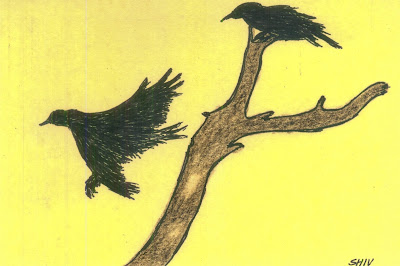Post Cards are a fun way of communicating. Postage (for hand written post cards) is only 50 paise. Create your own art work or messages on post cards and send them to your near and dear. I was inspired to do so by Russell Menzies and here they are - my first batch, ready to go out!
Monday, October 28, 2013
Wednesday, October 9, 2013
Bommai Kolu
Bommai Kolu
The old lady stood at the foot of the
ladder, arms on her hips, supervising and directing the operations. The little
boy sat in front of an open trunk in the attic, un-wrapping the dolls stored
inside and handing them down carefully. His two sisters sat at the foot of the
ladder, receiving the dolls handed down and dusting them.
The little boy was covered in dust and
cobwebs but he was happy. He was allowed to get up into the attic only twice a
year, just before Dasara and immediately after. This was something he loved to
do. His sisters too were enjoying their chore; chattering away to each other
while cleaning and getting the dolls ready to be put on display.
The little boy climbed down and
relaxed on the floor watching them. His work was done. It was over to the
ladies now.
The display steps, or “kolu padi” as they were known, were not
easy to set up. It took a couple of stools, a number of biscuit tins, stacks of
books, boxes, planks and the ingenuity of the grand lady to put it all
together. She was a past master at this, having done it for the last so many
years. She instinctively knew which tins would over go which stools at the two
ends, to achieve level and balance. Finally, when the planks were in place and
the whole assembly was checked for stability and passed, the steps were covered
with a couple of off-white “veshtis”.
It was hard toil, but the result was satisfying. The dolls could now be
arranged on these steps. Granny took care of the two steps on top while the
girls busied themselves with the bottom three. Traditionally, the number of
steps was always an odd number.
It would be a few years before the
youngest of the family would join his three siblings in Bangalore. Being old enough
to climb up the ladder to the attic, he would gleefully join them in the work.
Slowly, the display took shape. At the
centre of the top step was placed the “Kalasa”
holding a pomegranate surrounded by mango leaves. By its side, the two “marapachi” dolls (traditional dolls, a
man and a lady, made of a dark wood and dressed up in colourful costumes) were
placed. On either side were displayed the Shiva-Parvati and Rama-Sita sets. On
the next lower steps were placed the other sets like the Radha-Krishna-Gopikas
and the marriage procession sets. The bottom-most couple of steps were given
over to the single dolls, the porcelain statuettes and myriad others collected
over the years.
The Dasara display was ready.
Neighbours, friends and relatives would be invited to view the display. Every
day a different kind of sundal would
be prepared and distributed to all visitors.
Some seasons the children would create
a “park”. They would spread sand (collected from the neighbouring construction
site) on the ground near the display, carefully wet it and sprinkle mustard
seeds over it. They would make roads and walkways and place tiny toys at
strategic points. A couple of days later the mustard seeds would begin to
sprout and the “park” would look green and attractive.
Now the grand old lady is no longer there.
The “children” are all much older and two of them have children of their own.
But the tradition continues to this day. This year too, if you take some time
off to visit our home, you can see the “bommai
kolu” display and savour the sundal
of the day!
Happy
Dasara!
Dasara habbada hardhika
shubhashayagalu!
Subscribe to:
Comments (Atom)








